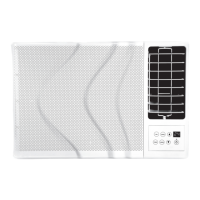4-4
5. Evacuation Manifold --- A evacuationmanifoldis
recommended for connecting the equipment needed for
a proper evacuation. The evacuation manifold can be
made easi ly as shown in Figure 4-3.
Packless
Valve
3/8 Flare
Fittings (4)
1/2 Flare Fitting
Tube
Stock
1 --- 1/ 2 in .
Packless
Valve
1/8 NPT
Fittings
1/8 NPT
Fitting (2)
1/4 Flare
Fitting
1/2 Flare
Fitting
Figure 4-3. Evacuation Manifold
b. Evacuation Procedure
NOTE
When a low side pump down has been
performed and after the low side has been
evacuatedthefi lter-dryeri nlet valveneedstobe
opened. Alsotheliquidlinesolenoidvalveneeds
to be manually energized.
To help speed up the evacuation process and to
increase the evaporation of moisture, keep the ambient
temperature above 60_F (15.6_C). If ambient
temperature is lower than 60_F (15.6_C), ice may form
before moisture removal is complete. Heat lamps or
alternate sources of heat may be used to raise system
temperature if necessary.
1. Before refrigerant removal and evacuation, leak
test unit.
2. Remove all remaining refrigerant charge in the
system.
3. Connect evacuation manifold, vacuum pump,
vacuum gauge, reclaimer and hoses as shown in
Figure 4-4.Allhandvalvesonmanifoldshouldbeclosed.
The compressor service valves should be midseated if
used. T he reclaimer valve should be closed.
4. Startvacuumpump.Slowlyopenmanifoldvalveto
the pump. Open valve to the vacuum gauge.
5. To open the liquid line solenoid valve, remove
LLS-TB10 wire and supply 24 volts. Evacuate unit until
vacuum gauge indicates 1500 microns (29.86 inches =
75.8 cm) Hg vacuum. Close gauge valve, vacuum pump
valve,andstopvacuumpump.
6. Opentherefrigerantcylindervaporvalvetobreak
the vacuum. Raise the pressure approximately 2 psig.
Thiswillabsorbanyremainingmoistureinthesystemfor
the second evacuation. Close the cylinder va lve.
7. Repeat steps 4 and 5.
8. Evacuate again as described in step 3 to 300---500
microns Hg vacuum.
9. Charge the system to specifications through the
refrigerant recovery machine (using manufactures
charging procedure) or as outlined in the following
section 4.8 (Charging the Refrigeration System).

